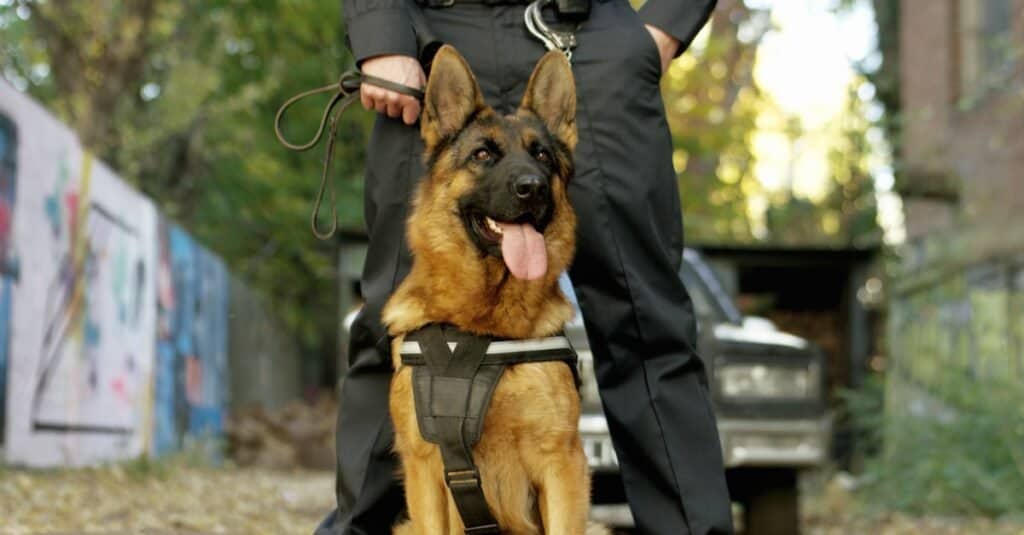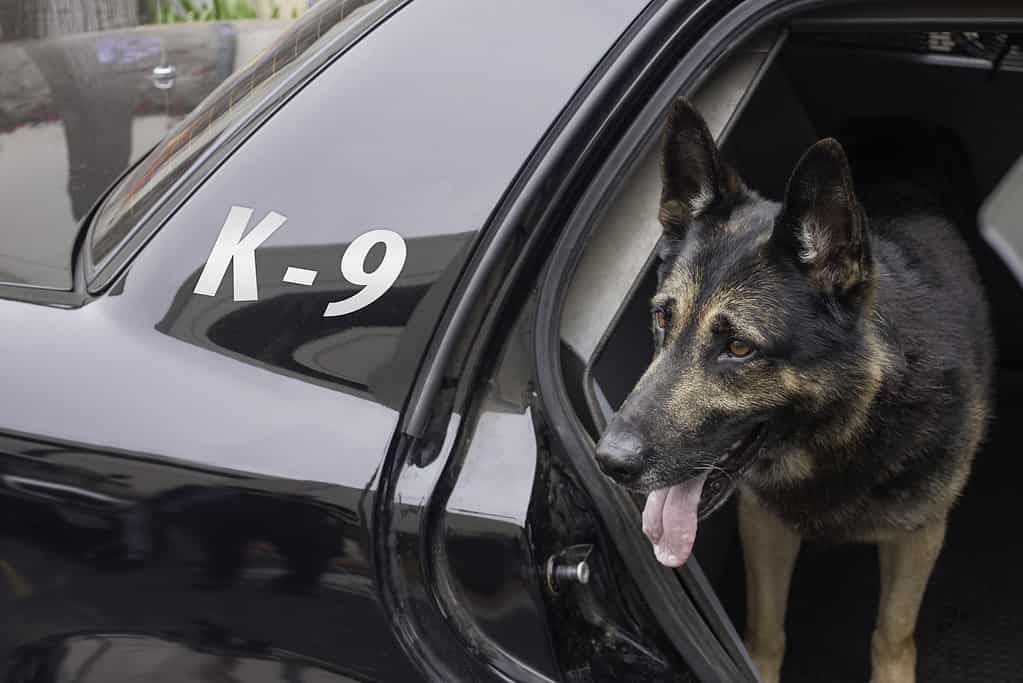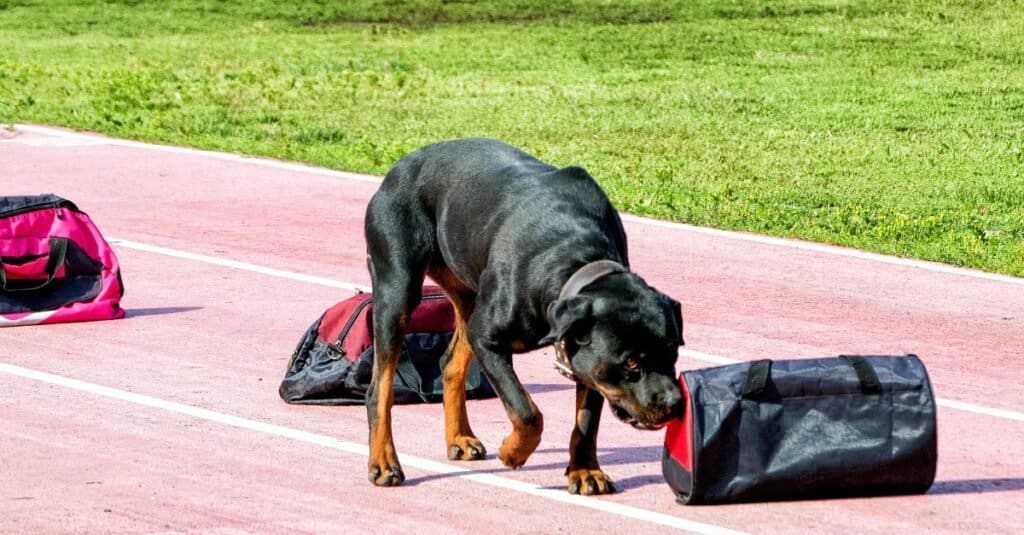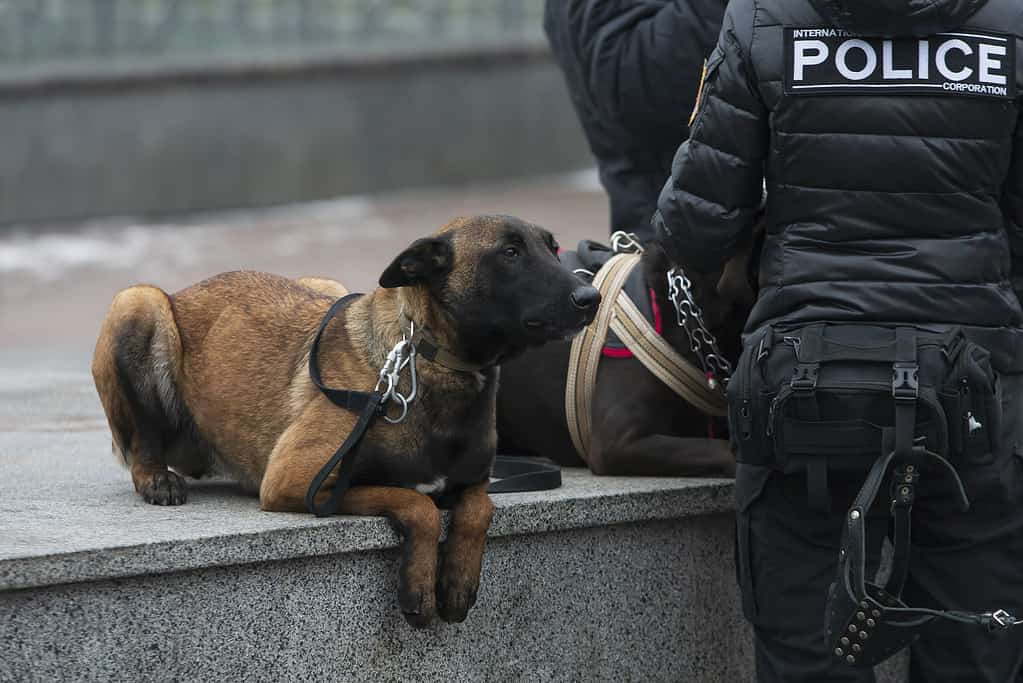For centuries dogs have been valued partners in protection and law enforcement, and their importance continues to grow today. Serving alongside their human officers, these highly trained canine companions work tirelessly to preserve the peace and keep communities safe. From carefully detecting hidden explosives to lightning-fast pursuits of dangerous suspects, their dedication never wavers. Their remarkable skills and unrelenting loyalty make police dogs irreplaceable assets and cherished partners in law enforcement.
What Is a K-9 Officer?

Becoming a K-9 officer involves extensive training and skill.
©VAKS-Stock Agency/Shutterstock.com
A K-9 officer, also known as a police dog, is a canine that has been specially trained as an active member of a law enforcement agency. They perform many different tasks as they assist their human handlers in protecting the community. The job of a police dog is anything but easy, and not just any canine is cut out to be a K-9 officer.
Breeds like German shepherds, Belgian Malinois, bloodhounds, Labrador retrievers, and Dutch shepherds, are specifically bred and trained for police work. These dog breeds have a long history and have been bred to work both independently and cooperatively with humans. Many of their ancestors served as herding dogs, bred over hundreds of years to be both physically strong and extremely intelligent. It is in their DNA to protect, solve problems quickly, and remain loyal to their human companions.
What Does It Take to Become a Police Dog?

Police dogs often work specifically in the department’s “K-9 Unit”.
©805promo/iStock via Getty Images
Police dogs are very expensive to acquire. They are primarily bred in Europe and transported to the United States, which can cost several thousand dollars. Police departments often use fundraisers to acquire enough money to bring in a new K-9 officer. These donations and fundraisers can also help to provide expensive, life-saving equipment for police dogs, such as specialized oxygen masks, bullet and stab protective vests, and cooling vests to keep them safe while on duty.
However, a dog needs more than just impressive ancestry and breeding to make it as a K-9 officer. Police dogs also undergo rigorous training, which costs police departments thousands of dollars. In addition to purchasing and training a dog, the police department must also provide appropriate housing and care for their K-9 officers and protect them from danger. This also adds to the already high-priced bills, but the benefits are well worth it in the end. Police dogs have keen senses, allowing them to sense things that humans simply cannot. Their incredible sense of smell, amazing eyesight, and natural agility make them indispensable in police work.
What Do Police Dogs Do?
Some police dogs are specifically trained for one special task, while other dual-purpose dogs may work in several different areas of police work. In general, police dogs are trained as experts in one or more of the following areas:
- Detection
- Tracking and apprehension
- Search and rescue
- Public relations and community engagement
Detection

Many police and military dogs are also trained to detect landmines.
©iStock.com/Sergei Ginak
Dogs have an incredible sense of smell, with 225 million scent receptors in their nose that allow them to read their environment quickly and accurately. In comparison, humans only have five million scent receptors. A well-trained detection dog can pick up on even the tiniest scents that humans would otherwise miss.
K-9 officers trained in detection may take on a variety of duties, from detecting harmful substances and explosives to finding clues at a crime scene. These dogs are trained to remain 100% focused on the scent, ignoring the countless other interesting sights and smells surrounding them.
Detection dogs are extremely useful in the field, as they can pick up on clues and other evidence that humans usually miss. When investigating arson, for example, a police dog can help detect accelerants. Police detection dogs commonly search civilian vehicles for illegal substances and narcotics. They are often employed at large events, arenas, theme parks, or airports where they help to detect illegal substances, explosives, and illegal imports.
Search and Rescue

Search and rescue dogs can even sniff out people buried after an avalanche!
©Evgenia Glinskaia/iStock via Getty Images
Another way that police dogs use their incredible sense of smell is in search and rescue operations. They help in cases of kidnapping, lost hikers, or after large disasters. Police dogs can move about and access areas that humans cannot get to safely, sniffing out clues and evidence of survivors, even if they are several feet below rubble or snow. Many K-9 officers are also trained to locate someone in the water who has drowned and other deceased persons. They track scents over several miles with astounding precision, making them invaluable to any search and rescue team.
Tracking and Apprehension

Officers in padded gear assist in police dog apprehension training.
©Zbynek Pospisil/iStock via Getty Images
Many police dogs are trained in tracking and apprehension. They are usually herding dog breeds, like Dutch shepherds, German shepherds, and Belgian Malinois. These dog breeds are extremely strong, intelligent, and loyal. They must be smart enough to detect threats and act on their handler’s signal.
Apprehension dogs are much faster than any human officer, so they are often sent in first when there is a fleeing suspect. They are trained to bite and hold the suspect, effectively detaining them until their human handler arrives. Apprehension police dogs are often the first ones to reach a threat, which also means that they continually put their lives on the line to protect their handlers.
Public Relationships and Community Engagement

Police dogs are trained to focus and tune out the distractions surrounding them.
©vzmaze/iStock via Getty Images
Police dogs also participate in educational demonstrations and community engagement. This helps the public to understand the role of the K-9 task force in protecting their communities. In addition, there are some honorary police dogs — often shelter dogs — that are trained for emotional support. They are brought into comfort and distract families during a crisis (i.e. watching their home burn to the ground, losing everything in an earthquake, waiting for survivors, etc.). These dogs may also accompany children to funerals or when visiting their families in the hospital after a tragedy.
K-9 Officer and Human Handler

Police officers form unbreakable bonds with their police dogs.
©Biserka Stojanovic/iStock via Getty Images
In most departments, police dogs are considered to be fully-fledged police officers, which is why they are called “K-9 officers”. Each dog is assigned a human handler, who helps with their training and care. The bond between a K-9 officer and their human handler is critical. These well-trained dogs have immense potential, but they rely on working seamlessly with their human handlers. K-9 teams must work in tandem, anticipate each other’s actions, and trust one another with their life.
The more trust there is between a dog and their human handler, the more control they have when dealing with dangerous situations. Many police dogs live with their handlers and travel exclusively in their patrol cars. Some departments also house K-9 officers in kennels where they are given the best care in between shifts.
What Happens to Police Dogs?

An annual Police K-9 Memorial Service is held in Washington, D.C.
©Federal Bureau of Investigation (FBI) / Public domain, via Wikimedia Commons – License
Health permitting, police dogs typically work until they are around 10 years old. When it is time, the dog retires, often receiving the same honors as a human officer. Following their police, a K-9 officer often lives as a family pet at home with their handler. In many departments, any police dog killed in the line of duty is recognized with the same honors as a human police officer.
The photo featured at the top of this post is © vzmaze/iStock via Getty Images
Ready to discover the top 10 cutest dog breeds in the entire world?
How about the fastest dogs, the largest dogs and those that are -- quite frankly -- just the kindest dogs on the planet? Each day, AZ Animals sends out lists just like this to our thousands of email subscribers. And the best part? It's FREE. Join today by entering your email below.
Thank you for reading! Have some feedback for us? Contact the AZ Animals editorial team.






